Chapter 5 Our people
The Institute relies on highly skilled and competent people to support the achievement of its strategic directions, and strives to provide a workplace that offers fulfilling and challenging work. Our friendly and nurturing work environment promotes the professional and personal development of all staff. We strive to be a versatile and adaptable organisation with a wide range of skills necessary to produce high-quality reports and other products and deliverables, on time and within budget.
Our most significant staffing and facilities challenge for 2015–16 was the transfer of certain functions from the National Health Performance Authority (NHPA) to the AIHW. The NHPA was closed on 30 June 2016. However, to provide a smooth transition and ensure business continuity, 20 NHPA staff voluntarily transferred to a newly created Health Performance and Accountability Framework Group within the AIHW on 21 April 2016. Several of these staff were based in NHPA's Sydney office, the lease for which was re-assigned to the AIHW with effect from 1 July 2016. Further details are provided throughout this chapter.
Staff profile
Employment numbers and categories
We employed 310 active staff at 30 June 2016—including those staff who transferred from the NHPA—compared with 308 active staff at 30 June 2015 (Table 5.1). The number of active full-time equivalent staff increased from 284.8 at 30 June 2015 to 286.6 at 30 June 2016.
Table 5.1: Active staff and total staff, 2013–2016
| Staff | 30 June 2013 | 30 June 2014 | 30 June 2015 | 30 June 2016 |
|---|---|---|---|---|
| Active staff | 343 | 322 | 308 | 310 |
| Staff on long-term leave | 20 | 25 | 31 | 37 |
| Total staff | 363 | 347 | 339 | 347 |
| Staff | 30 June 2013 | 30 June 2014 | 30 June 2015 | 30 June 2016 |
|---|---|---|---|---|
| Active staff | 313.5 | 297.4 | 284.8 | 286.6 |
| Total staff | 331.3 | 319.6 | 313.9 | 321.6 |
Note: 'Staff on long-term leave' refers to staff on any form of continuous leave for more than 3 months—for example, long service leave and maternity leave.
The number of staff on long-term leave of more than 3 months increased to 37 at 30 June 2016, compared with 31 a year earlier. Five of these staff had transferred to the AIHW from the NHPA.
Of our active staff at 30 June 2016:
- 15 had transferred from NHPA
- 280 (90.3%) were ongoing employees—a small increase on the 272 (88.3%) level of a year earlier, but less than for the previous 2 years
- 81 (26.1%) worked part-time—continuing a pattern of small decreases each year for the last 3 years (Figure 5.1)
Figure 5.1: Category of staff employment, 2013–2016 (30 June)
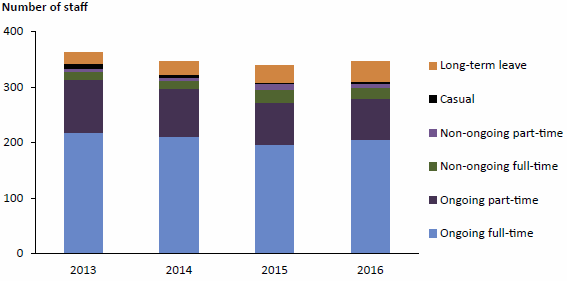
Notes
-
Staff in all categories except the long-term leave category are 'active.
-
Data for this figure and category definitions are available in Table A8.25.
Classification level
Of our active staff at 30 June 2016, just under one-third (98 staff) were classified and employed as Executive Level 1 (EL 1) officers and about one-quarter (80 staff) were employed as Australian Public Service (APS) 6 officers (Figure 5.2).
The proportion of active APS full-time equivalent (FTE) staff rose again this year to 55.4%, following increases over the previous 2 years. The proportion of active EL FTE staff fell again to 42.5%, after decreases over the previous 2 years. The most notable changes between the previous and current year related to APS 6 level staff—where the proportion rose—and for APS 4 staff—where the proportion fell.
Figure 5.2: Active full-time equivalent staff by classification level, 2013–2016 (30 June)
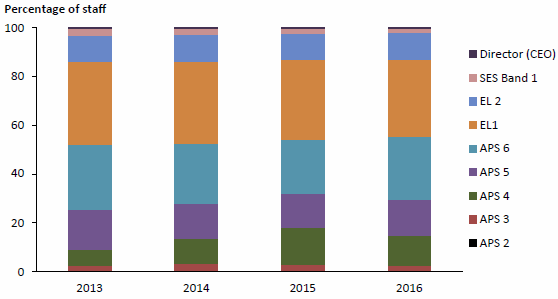
Note: Data for this figure are available in Table A8.26.
Groups
Of our active staff at 30 June 2016, 243 (78.4%) were employed in statistical work-related functions across 7 groups, and 66 (21.3%) were employed in corporate work-related functions across 4 groups (Table 5.2). (Three groups undertake both statistical and corporate services work.)
Over the year, active staff numbers in the Indigenous and Children's Group and the Health Group fell by 12 and 7, respectively. In the Data Strategies and Information Technology Group, the primary focus of work changed by 4 staff from corporate to statistical functions.
Table 5.2: Active staff employed, by group, 2015 and 2016
| Staff | 30 June 2015 Total |
30 June 2016 Ongoing |
30 June 2016 Non-ongoing and casual |
30 June 2016 Total |
|---|---|---|---|---|
| Director (CEO) | 1 | — | 1 | 1 |
| Statistical groups | — | — | — | — |
| Community Services and Communication (statistical functions) | 22 | 22 | — | 22 |
| Data Strategies and Information Technology (statistical functions) | 10 | 15 | 1 | 16 |
| Health | 55 | 47 | 1 | 48 |
| Health Performance and Accountability Framework (statistical functions) | — | 13 | 6 | 19 |
| Hospitals, Resourcing and Classifications | 42 | 37 | 2 | 39 |
| Housing and Specialised Services | 53 | 48 | 4 | 52 |
| Indigenous and Children's | 59 | 40 | 7 | 47 |
| Subtotal | 241 | 222 | 21 | 243 |
| Corporate groups | — | — | — | — |
| Business and Governance | 25 | 22 | 5 | 27 |
| Community Services and Communication (corporate functions) | 12 | 10 | 2 | 12 |
| Data Strategies and Information Technology (corporate functions) | 29 | 25 | — | 25 |
| Health Performance and Accountability Framework (corporate functions) | — | 1 | 1 | 2 |
| Subtotal | 66 | 58 | 8 | 66 |
| Total | 308 | 280 | 30 | 310 |
Note: Information for 3 groups has been split to show staff whose functions are (primarily) statistical or corporate.
Workforce management
We continue to attract and retain talented staff by offering challenging and fulfilling work, competitive salaries, flexible working conditions, excellent learning and development opportunities, and a friendly and inclusive work environment.
Staff commencements and turnover
Fifty-eight new employees commenced ongoing employment with the Institute during 2015–16 (Table 5.3), of which 19 ongoing staff were transferred from the NHPA and 21 were our 2015–16 graduate intake.
A total of 44 ongoing employees exited AIHW during 2015–16, of which 27 moved to another APS agency—including 6 who moved on promotion. The remaining 17 separated from AIHW via resignation (10) or retirement (7). This equates to a 14.6% exit rate for ongoing staff in 2015–16 and represents a continuing increase when compared with recent years' exit rates of 9.9% in 2014–15 and 4.0% in 2013–14.
Table 5.3: Commencements and separations of ongoing staff, 2015–16
| Type | Number |
|---|---|
| Ongoing staff at 30 June 2015 | 302 |
|
+31 |
|
+27 |
| Total commencing staff | +58 |
|
-10 |
|
-7 |
| Sub-total separating staff | -17 |
|
-21 |
|
-6 |
| Total exiting staff | -44 |
| Ongoing staff at 30 June 2016 | 316 |
Notes
-
'Ongoing staff' refers to staff employed on an ongoing basis, whether active or on long-term leave.
-
Staff aged 55 and over who resigned are counted as having retired.
AIHW graduate intake
Our annual graduate intake remains a key strategy for building the AIHW's workforce capability. We offer excellent employment opportunities for suitable graduates seeking to apply their qualifications in the fields of health and welfare information.
Of the 21 graduates employed in the 2015–16 intake, 6 relocated from interstate/overseas, while 10 were already employed by the AIHW on a non-ongoing basis. Of the 12 graduates employed in the 2011–12 intake, 5 remain at the AIHW (Table 5.4).
Table 5.4: Graduate recruitment intake and outcomes, 2011–12 to 2015–16
| Intake and outcomes | 2011–12 | 2012–13 | 2013–14 | 2014–15 | 2015–16 |
|---|---|---|---|---|---|
| Graduate intake (all at APS 4 level) | 12 | 7 | 8 | 8 | 21 |
| Graduates remaining at the AIHW at 30 June 2016 | 5 | 4 | 7 | 5 | 19 |
|
— | — | — | 2 | 19 |
|
2 | 4 | 7 | 3 | — |
|
3 | — | — | — | — |
|
— | — | — | — | — |
Managing performance and behaviour
Our Performance Communication and Feedback Policy recognises that regular constructive feedback encourages good performance, enhances continuing development and encourages staff to communicate with each other informally and regularly about performance matters. It also recognises that formal assessment and feedback are important and requires all staff to have two formal communication and feedback sessions each year.
Annual Individual Performance Agreements (IPAs) are designed to align individual performance to our strategic priorities and annual (financial year) work plan, with the overall aim of improving individual and organisational performance. IPAs also focus on individual learning and development needs and broader APS career development. AIHW policy requires a current IPA to be in place for existing staff by July-August each financial year and, for new employees, within 3 months of their commencement at the Institute. In all, 279 staff had an IPA in place at the beginning of the 2015–16 cycle, and 294 staff participated in the mid-cycle review of the IPAs during January-February 2016.
Recognising diversity
We continue to recognise and support the diversity of our people. The AIHW's Enterprise Agreement provides flexible working and leave arrangements to support employees' caring responsibilities, religious commitments and attendance at events of cultural significance, including Institute-organised activities that commemorate Indigenous histories, cultures and achievements.
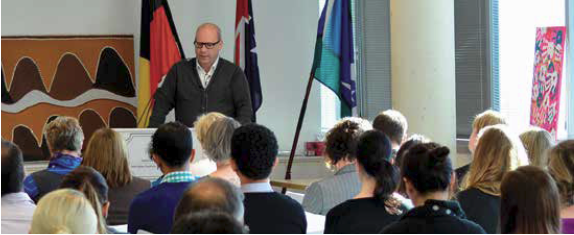
Mr Craig Ritchie presenting at an event organised for staff during National Aboriginal Islander Day Observance Committee Week in July 2015.
Figure 5.3 compares the proportions of AIHW staff with APS staff overall in terms of identifying as of Aboriginal and/or Torres Strait Islander background, having disability, or being from a non-English speaking background, as well as the proportion of staff who are women, or aged 50 or over.
Figure 5.3: Staff diversity groups, 2015 and 2016
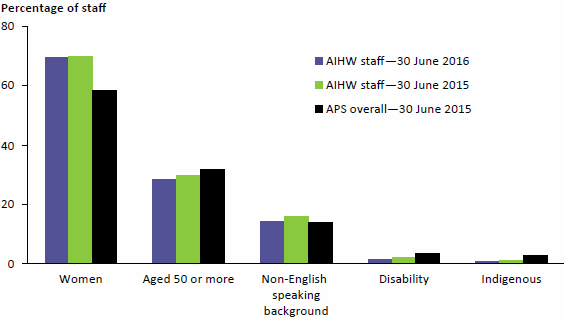
Note: Data for this figure are available in Table A8.27.
More than two-thirds of our total staff (69.5%) at 30 June 2016 were women. Among our active staff, 2 of our 5 substantive Senior Executive Service (SES) Band 1 staff are women, and women represent nearly two-thirds (62.6%) of our EL staff.
We maintain a Workplace Diversity Program aimed at ensuring that:
- we recognise, foster and make best use of the diversity of our employees within the workplace
- we help employees to balance effectively their work, family and other caring responsibilities
- we comply with all relevant anti-discrimination laws.
The Institute has a Reconciliation Action Plan and has appointed two members of the Senior Executive group in the roles, respectively, of Disability Champion and Indigenous Champion.
Terms and conditions of employment
Enterprise Agreement
The Institute's current Enterprise Agreement (EA) came into effect on 22 October 2012 and nominally expired on 30 June 2014. It covers all non-SES staff employed under the Public Service Act 1999 and will operate until a new agreement comes into effect. Bargaining commenced in June 2014, and continued through to February 2016. A proposal put to a staff vote at the end of February was rejected by a majority of voting staff. Further negotiations occurred after the ballot, but bargaining was put on hold during the caretaker period leading up to the federal election.
Remuneration
Salary ranges based on classification level from our current EA are shown in Table 5.5. The salary regime does not provide access to, or include, performance pay.
Table 5.5: AIHW Enterprise Agreement salary range for APS and EL employees, 30 June 2016
| Level | Salary points ($) Lowest |
Salary points ($) Highest |
|---|---|---|
| APS 1 | 42,098 | 47,225 |
| APS 2 | 48,954 | 53,623 |
| APS 3 | 55,676 | 60,918 |
| APS 4 | 62,405 | 67,589 |
| APS 5 | 69,573 | 74,519 |
| APS 6 | 78,033 | 86,263 |
| EL 1 | 95,443 | 106,468 |
| EL 2 | 116,804 | 131,267 |
SES remuneration
The terms and conditions of employment for SES staff are contained in common law contracts, including remuneration. They provide for salary entitlements, as well as non-salary inclusions relating to leave arrangements and entitlements, superannuation, salary sacrifice, travel and allowances. As at 30 June 2016, the range within which SES Band 1 salaries can be set by the AIHW Director was $160,000 to $190,550. Note 12 in Appendix 9 provides details of overall senior management personnel remuneration, including that for the AIHW Director and non-executive directors.
Individual flexibility arrangements
Our EA contains provisions for individual flexibility arrangements to enable tailoring of remuneration and conditions for individual employees in particular circumstances. At 30 June 2016, 4 non-SES staff had individual flexibility arrangements in place.
Engaging with staff
We recognise that engaging with staff in decisions that affect them can lead to better service delivery, use of resources, overall performance and staff experiences. Our staff consultative arrangements include several formal committees.
Consultative Committee
The Consultative Committee is the principal forum through which formal consultation and discussions on workplace relations matters take place between management and employees.
Consultative Committee processes support the change management and consultation obligations outlined in the Institute's EA. The committee discusses workplace relations matters in a spirit of cooperation and trust.
The committee met 4 times during 2015–16 and, among other issues, discussed matters arising during the year pertaining to the movement of staff from the NHPA, changes to the AIHW's Rehabilitation and Return to Work Policy, and the impacts and performance of technology to assist staff with their work.
Health and Safety Committee
The Institute maintained a Health and Safety Committee during 2015–16 as required by Division 4 of the Work Health and Safety Act 2011 (WHS Act). The committee facilitates cooperation between management and employees in instigating, developing and carrying out measures designed to ensure the health and safety of our people at work.
The committee met 4 times during 2015–16 and, among other matters, reviewed the process for workstation assessments by occupational therapists.
Learning and Development Advisory Committee
The Learning and Development Advisory Committee provides strategic direction for, and enables stakeholder input to, the planning and delivery of learning and development initiatives across the Institute. The committee comprises representatives from the various AIHW Groups.
The committee met 3 times during 2015–16.
Social Club
The Institute has an active Social Club, which focuses on coordinating social activities and events that help foster a positive and collaborative workplace environment. The club, the members of which include staff from the latest graduate intake each year, takes the lead in organising the annual staff Christmas party, and other events held throughout the year.
Recognising and building expertise
We recognise and make good use of the high levels of education and skills of our staff, both of which are critical to performing the complex work of the Institute.
Staff qualifications
Of the 190 AIHW staff (62.1% of all eligible staff) who responded to the 2016 APS Commission's State of the Service Employee Survey, 167 (87.9%) reported having tertiary-level qualifications. These qualifications covered a broad range of fields, including health sciences, social sciences, education, information technology and business.
External study
The Institute has a Studybank program which supports staff in undertaking formal external study for a recognised qualification relevant to the AIHW's work. Fourteen staff received assistance for formal study during Semester 2 2015 and Semester 1 2016. Areas of study included psychology, public health and business.
Corporate learning and development program
We continue to invest in the learning and development of all our staff through a range of in-house learning and development programs, including formal induction for all new employees.
We provided in-house courses on 57 occasions during 2015–16 under the Institute's Corporate Learning and Development Program. These courses were attended by 530 staff in total (with some staff attending more than one course). The 2015–16 program once again focused on skills training in the areas of leadership and management, written communication, statistical and data analysis, and corporate competencies.
SAMAC conversations
The Statistical and Analytical Methods Advisory Committee (SAMAC) holds regular 'conversations' which aim to provide a forum for staff to:
- access relevant expertise
- discuss emerging practices and their implications
- share innovative and potentially reusable practices
- broaden their knowledge of the work of the Institute
- hone their skills in strategic conversation
- develop habits of constructively giving and receiving feedback on analytical issues.
Eleven conversations were held in 2015–16. Some of the topics discussed were:
- Quality assurance—frameworks and in practice
- Geospatial information systems—case studies of geospatial analysis
- Data linkage—an update of what's new in data linkage
- Longitudinal data analysis—a discussion of applicable tools
- Big data—what it is and how to make use of it.
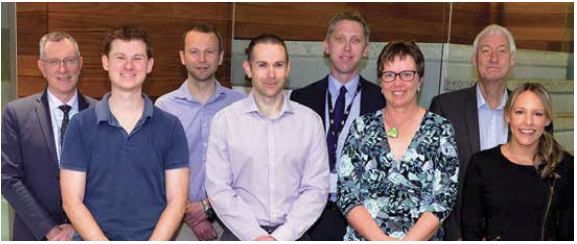
AIHW staff who presented SAMAC conversations.
Left to right: Geoff Neideck, James Thompson, Martin Edvardsson, David Whitelaw, Nick Von Sanden, Melissa Goodwin, Phil Anderson and Michelle Gourley.
Absent: Vanessa Prescott, Mark Walker.
Institute Awards
In 2016, the AIHW introduced Institute Awards to recognise exceptional individual and team contributions to the Institute. All staff were invited to nominate an employee or team for the awards, and the AIHW Director considered them and decided who to recognise through these awards.
Institute Awards were given out to 3 staff and 3 teams (Table 5.6).
Table 5.6: Institute Awards, March 2016
| Name | For enhancing the AIHW's reputation and innovation through: |
|---|---|
| Ellen Connell | Increasing the reputation of the AIHW through publication of a report. |
| Gary Kent | Outstanding work in improving the AIHW's external relationships. |
| David Whitelaw | Enhancing the AIHW's reputation as a professional organisation by providing outstanding support work to statistical analysis. |
| Housing and Homelessness Collection Operations, Field operation team | Enhancing the AIHW's reputation, through the dedication and commitment to going above and beyond their day-to-day operations to ensure that high-quality service is provided to stakeholders. |
| Housing and Homelessness Reporting and Development Unit | Outstanding work on the first report to specifically examine the issue of domestic violence and homelessness using the Specialist Homelessness Services Collection. |
| Indigenous Modelling and Spatial Analysis Unit, Mapping/spatial analysis team | Innovation (and enhancing the AIHW's reputation) in the spatial analysis of Indigenous data on access to services. |
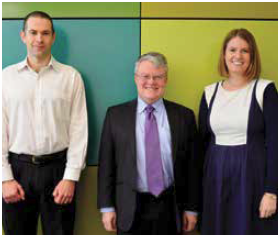
Institute Award individual recipients.
Left to right: David Whitelaw, Gary Kent and Ellen Connell.
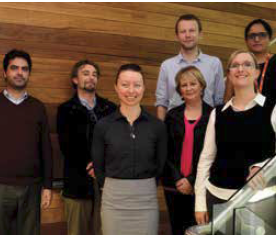
Institute Award teams recipients.
Front row (left to right): Mark Walker, Brett Nebe, Michelle Barnett, Katrina Williams and Allison Julian.
Back row (left to right): Martin Edvardsson and Shivani Sharma.
Long-serving staff
During the year, 15 staff were presented with service awards as they had reached their 10 years or 20 years of service anniversaries at the Institute (Table 5.7).
Table 5.7: Staff long-service anniversary recognition, 2015–16
| 20 years | 10 years | 10 years | 10 years |
|---|---|---|---|
| Jenny Hargreaves | James Aken | Mardi Ellis | Michele Mullins |
| Lynelle Moon | David Batts | Alison Evans | Andrew Powierski |
| ? | Karen Bishop | Michelle Harvey | Mark Short |
| ? | Tracy Dixon | Belinda Hellyer | ? |
| ? | Deanna Eldridge | Nicole Hunter | ? |
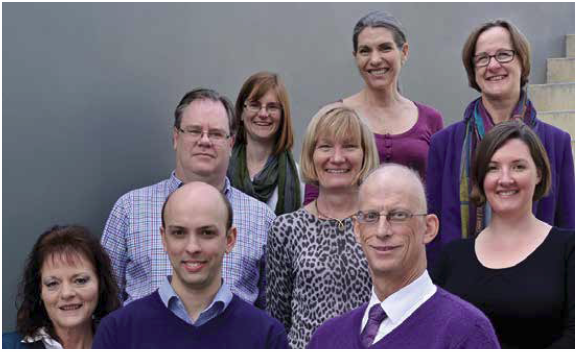
Staff who were recognised in 2015–16 for reaching their 20- or 10-year service anniversaries.
Back row (left to right): Michelle Harvey, Belinda Hellyer and Lynelle Moon.
Middle row (left to right): Mark Short, Alison Evans and Mardi Ellis.
Front row (left to right): Michele Mullins, Andrew Powierski and David Batts.
Absent: James Aken, Karen Bishop, Tracy Dixon, Deanna Eldridge, Jenny Hargreaves and Nicole Hunter.
Encouraging work health and safety
We are committed to maintaining a productive and safe work environment for all staff and to meeting our obligations under the WHS Act. Senior managers, supervisors, Health and Safety Representatives, the Health and Safety Committee, and all AIHW staff work cooperatively to ensure that work health and safety (WHS) risks are effectively managed.
Initiatives and outcomes
During the year, we continued to focus on early prevention strategies. All staff have sit-stand workstations and professional training in initial workstation set-up.
The Institute also introduced several other initatives during the year to ensure WHS, and to advance the overall wellbeing of staff. Table 5.8 provides a summary of the key WHS initiatives undertaken during 2015–16.
Table 5.8: Key work health and safety initiatives, 2015–16
| Initiative | Outcomes |
|---|---|
| WHS-related training—for managers | 5 courses; 23 attendances by managers |
| WHS-related training—for staff | 9 courses; 84 attendances |
| Workstation assessments by an occupational therapist | 22 assessments conducted |
| Workplace safety inspections | 4 inspections conducted |
| Employee Assistance Program | Staff utilisation rate: 8.8% (for 1 March 2015 to 28 February 2016) |
| Flu vaccinations | 149 vaccinations were administered to staff (representing 43.1% of total staff in March 2016) |
| Discounted gym membership | 59 staff used this membership option (at 30 June 2016) |
Rehabilitation Management System audit
An external audit of the Institute's Rehabilitation Management System (RMS) was undertaken in late 2015 in keeping with Comcare's Guidelines for Rehabilitation Authorities 2012.
The audit found that the Institute has established rehabilitation management arrangements which cover many, but not all, of the structural elements of an RMS. Further development of existing elements, along with some new elements, were recommended to enable the arrangements to function as an effective system for rehabilitation management. The key areas requiring action included the development of RMS objectives, rehabilitation provider performance evaluation and more detailed reporting of RMS outcomes.
The audit report, including recommendations and an action plan, were accepted by the Institute in December, with the majority of action items addressed before 30 June.
The auditor has provided the Institute with a Certificate of Compliance which has been forwarded to Comcare in keeping with its guidelines. The certificate provides Comcare with assurance that the Institute's RMS is meeting Comcare's requirements for rehabilitation authorities.
Incidents and compensation
Despite the active promotion and implementation of various prevention measures, some workplace incidents/injuries occurred.
In 2015–16, 5 new compensation claims were lodged with Comcare (0 accepted, 3 denied and 2 yet to be determined), compared with 4 claims lodged and accepted in 2014–15, 3 claims lodged (2 accepted) in 2013–14 and 2 claims lodged (2 accepted) in 2012–13.
Of the 2015–16 claims, 2 were for psychological conditions and 3 were for physical conditions.
Notifiable incidents and investigations
Under the WHS Act, the AIHW is required notify Comcare (the regulator) when incidents occur that involve the death of a person, a serious injury or illness, or a dangerous incident as detailed in the WHS Act.
One incident was notified to Comcare during the year as a serious injury or illness.
Workplace inspections and Comcare investigations
During the year, our Health and Safety Representatives and staff responsible for facilities carried out 4 inspections of our workplace. These inspections occur about a fortnight before Health and Safety Committee meetings to enable findings and recommendations to be considered and actioned quickly. Changes made during 2015–16 were of a minor nature, such as the removal of trip hazards and improved health and safety signage.
No investigations by Comcare (the regulator) were conducted in 2015–16. No directions, notices, offences or penalties were served against the AIHW under the WHS Act.
Accommodation and energy efficiency
The AIHW operated from a single office building in Canberra for most of 2015–16, located at 1 Thynne Street, Bruce. The AIHW was in the second year of a 15-year lease on the 3-storey building and its basement and open-air car parks. The building was purpose-built to suit AIHW's functional requirements, which included flexibility in layout.
The whole building is designed to achieve a 4.5-star National Australian Built Environment Rating System (NABERS) rating.
Tables 5.9 and 5.10 provide more information on our efforts to reduce AIHW's impact on the environment.
Sydney-based staff who transferred to the Institute from the NHPA continued to operate from an office at Level 9, 1 Oxford Street, Sydney. The AIHW took over the lease for a portion of these premises from 1 July 2016.
Ecological sustainable development
We uphold the principles of ecologically sustainable development outlined in the Environment Protection and Biodiversity Conservation Act 1999 and are committed to making a positive contribution to achieving the objectives of the legislation (see tables 5.9 and 5.10). Section 516A (6) of the Act requires the AIHW to report on environmental matters, including ecologically sustainable development.
Table 5.9: Ecologically sustainable development reporting, 30 June 2016
| Reporting area | Activitities undertaken by the AIHW |
|---|---|
| Legislation administered during 2015–16 accords with the principles of ecologically sustainable development | The AIHW does not administer legislation. |
| The effect of the AIHW's activities on the environment | The AIHW's key environmental impacts relate to the consumption of energy and goods, and waste generated by staff in the course of business activities. Table 5.10 includes available information on energy consumption and recycling of waste. |
| Measures taken to minimise the impact of AIHW activities on the environment |
Provision of amenities for staff who ride bicycles to work. Use of energy-efficient lighting, including the installation of light-emitting diode lighting in selected areas. Purchasing 10% GreenPower electricity. Purchasing only energy-efficient equipment that is Energy Star compliant. 'Shutting-down' multifunctional devices when they are left idle for long periods. Movement-activated lighting that turns off after 20 minutes of no movement being detected. Double-glazed windows to increase the efficiency of heating and cooling. Installation of a modern, efficient air-conditioning system. Installation of rainwater tank system to supply the toilets, urinals and external taps. Recycling of toner cartridges and paper. Purchasing only paper with at least 50% recycled content for printing and copying. Re-use of stationery items such as ring binders. Recycling bins in AIHW kitchens for collection of organic waste. Printing of our publications using 'print-on-demand' processes is done using paper sourced from sustainably managed, certified forests in accordance with ISO14001 Environmental Management Systems and ISO9001 Quality Management Systems. |
| Mechanisms for reviewing and improving measures to minimise the impact of the AIHW on the environment | During 2015–16, the AIHW worked to comply with benchmark environmental impact indicators at 1 Thynne St, which is designed to achieve a 4.5-star National Australian Built Environment Rating System rating. |
The significant decrease in toner cartridge recycling and use of paper continued in 2015–16 (Table 5.10) due to the central printing pools in the buildings, increased use of the Institute's online project management system and increased staff use of a redeveloped intranet site. All of these initiatives appear to have contributed to the printing of fewer hard copies of documents by staff.
Table 5.10: Energy consumption and recycled waste, 2011–12 to 2015–16
| Consumption and recycled waste | 2011–12 | 2012–13 | 2013–14 | 2014–15 | 2015–16 |
|---|---|---|---|---|---|
| Energy consumption | ? | ? | ? | ? | ? |
| Electricity (kilowatt hours, as office tenant light and power)(a) | 827,312 | 858,439 | 753,153 | 630,093 | 689,494 |
| Paper (reams) | n.a. | 3,380 | 2,570 | 1,620 | 1,605 |
| Recycled waste | ? | ? | ? | ? | ? |
| Organics from kitchens (tonnes) | 2.4 | 1.8 | 2.4 | 2.5 | 2.3 |
| Toner cartridges (number) | n.a. | 331 | 329 | 74 | 81 |
Office air-conditioning is metered to the base building while light and power are separately metered.
Government greenhouse and energy reporting
The Australian Government's Energy Efficiency in Government Operations policy helps government agencies to identify opportunities to save energy. The AIHW is required to comply with the policy because it derives more than half the funds for its operations from the Commonwealth, either directly or indirectly.
The policy requires agencies to comply with certain minimum energy performance standards, including the requirement that eligible new leases contain a Green Lease Schedule with at least a 4.5-star NABERS energy requirement. As outlined earlier in this chapter, the lease agreement for 1 Thynne Street meets this requirement.



